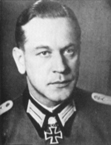mazorj
Posts: 19
Joined: 6/1/2004
Status: offline

|
quote:
ORIGINAL: Gregor_SSG
Its encouraging to see people treating the AI as if it has knowledge about the game in the same way that a human player does, as this means that its doing a reasonable job. In truth, like the Wizard of Oz, it's all done by smoke and mirrors. The AI doesn't 'know' anything about your forces, and certainly doesn't know that it has a left flank - that's a very human concept and the AI is nowhere near smart enough to deal with such a fluid concept.
What the AI has is a bunch of rules and hints/commands from the scenario designer and each formation applies those rules without ever trying to consider the bigger picture. The bigger picture is supplied mostly by the change of ownership of geographical objectives. For example, the Russian 6th Army and AG Bobkin will continue their offensive towards Krasnogrd and Kharkov until Izyum falls, whereupon they get a new plan.
The big advantage for the AI with the new AO system is that the area that it operates in and the forces that it has to operate with are precisely known. This makes it much easier for the scenario designer to give precise instructions.
In the example above, the question of whether the AI worries about its left flank is primarily answered by the scenario designer. If he wants the flank guarded he can specify some defensive hexes that the AI will try to protect. However, even if he doesn't do that, the AI does have underlying routines that will cause it to seek out enemy units and attack if possible so AI units could end up on the left flank anyway. It's hard to be more precise because the scenario designer is mostly giving high level commands/suggestions and the underlying routines that are finally in charge of moving and attacking are necessarily autonomous.
So to summarise, the AI never sees the whole game like a human player does. The only possible advantage that the AI could have is its ability to calculate all possible combats and attack at the most advantageous odds. This is removed by the fact that we give the human player access to the same ability through the Combat Advisor and that the only basis the AI has for choosing between competing high odds combats is the higher level hints from the scenario designer, which never be as acute or relevant as those generated by a human player able to look at all levels of the game in a single glance.
Gregor
First, thanks for your illuminating responses. I have a few of my own, in no particular order:
The original post here mentioned time/distance scales. I don't have a problem with the kinds of movements that can be made, they seem reasonable. My concern is the more general one of sequencing movements and attacks. An astute human player will first scan the Combat Advisor's offerings, determine which hexes are priority targets, check for artillery/air support to increase the odds of getting a desired result against each hex, move units out of attack hexes if they are blocking additional attack units from participating, and then sequence movements and attacks to the best advantage. (See below on how to maximize combat results.) For example, eliminating or moving enemy units out of one hex may create another green triangle against the next target, but not vice versa, so you know which one to attack first. On a broader scale, I may go back and forth, making movements and attacks in two different but nearby attack areas, and halfway into those routines, allocate additional available units based on the initial combat results and which of the two attack areas will benefit most from additional combats. After those attack areas are resolved, I'll look for the next ones based on the previous outcomes. And after that, I'll start realigning the attacking units and bringing in other units for an optimum defense configuration against counterattack.
The problem is, some of the movements made throughout this routine require the moving unit's max or near-max movement allowance, which indicates one full day's movement. So these units would have had to start moving at the same time as the attacks I initiated - but I didn't have to order them to move until a half- to a full day's battles already had occurred! This "time warp" advantage increases with the game's basic unit of time per movement, and decreases if a day is broken into two or more moves. So, all other things being equal, a smaller time unit per turn will make for more realistic play by reducing the human player's "time warp" advantage.
Re the Combat Advisor, there's more to it than "don't just blindly follow it and attack where it offers the biggest odds". In addition to looking for the overview, there are many exploits for the human player. After selecting a combat, I try to sneak up on odds. First make an attack with existing units to see what you're up against - not only the current odds, but how many are needed to make the next level of odds. If the defense factor is, say, 49, it's going to take a lot of units to bump the odds, whereas you often can cheaply eliminate an entire stack at 12-1 or 20-1 if there's only 20 or less defensive points. Bring in big units first, try to get the green triangle sides filled, and avoid attacking across major river sides. Exit that attack, refresh the CA, scan to see which units are needed next to bump up the odds, and repeat the move-attack-exit-refresh routine until you get the max (or an acceptable level of) odds. Many times you don't need several of the units that the CA wanted to commit to get the same outcome. The Undo button is your friend. So is moving out units that can't attack so that more attack units can get in play. (Watch how often the CA's odds increase just by doing that!) Furthermore, my priorities for attacks are influenced by whether I can totally eliminate a unit that turn. I'll take even 1-1 odds over a 5-1 on another hex if it means eliminating a unit as opposed to inflicting 1 or 2 steps on a unit that has 6 more in reserve. The AI doesn't do any of that, so between tweaking each combat and the ability to see the bigger tactical and strategic considerations, the human player has a tremendous advantage in making attacks.
Re the AO: Any new feature will be exploited in some manner, but on balance I think it is quite successful in terms of the stated objectives. True, units can get cut off from their HQ when a small excursion through a prohibited AO would put them back in contact, but the designer can say that the fog of war prevented them from knowing that. The only real problem I have with the AO feature is when units on the run from overwhelming attacks get trapped because they are jammed up against their boundaries. I'm not sure that under those conditions, even the most ruthless commanders and commissars could always keep a desperate unit from fleeing the field out of their AO.
I've commented previously on the manual. While some of the critiques here are somewhat marginal, I agree with the general thrust that information often is not in the place that you expect and need to find it. And please lose the background graphics or screen them way, way down. Just because something looks legible on a page layout monitor screen doesn't mean that it will maintain its legibility when it comes off the printing presses.
Bottom line: I started with AH's Tactics II and Gettysburg ~1960 and have been an avid player since then. IMO Kharkov is the latest high point in the continuing evolution of this game genre.
 Attachment (1) Attachment (1)
< Message edited by mazorj -- 10/1/2008 7:29:03 PM >
|
 Printable Version
Printable Version















 New Messages
New Messages No New Messages
No New Messages Hot Topic w/ New Messages
Hot Topic w/ New Messages Hot Topic w/o New Messages
Hot Topic w/o New Messages Locked w/ New Messages
Locked w/ New Messages Locked w/o New Messages
Locked w/o New Messages Post New Thread
Post New Thread